|
BMW
|
1916
- |
Country: |
 |
|
THE BAYERISCHE MOTOREN WERKE is not one of the old, original European car firms; in fact BMW came on the scene relatively late, in 1916. Nor was it a company which was founded by a single visionary.
Instead, it has its origins rooted in the development of two complementary companies and it made its reputation in racing and record breaking in various spheres. History has shown that companies which race always attract attention - either for winning or for skirting bankruptcy. BMW came very close to achieving both.
After each world war, the Bavarian factory managed to survive through occupation eras, years of industrial and financial depression and often poor management decisions, to ward off merger bids and rise again, independent and, eventually, successful.
Any study of BMW history must begin with aviation; the company's badge is based on the stylized blur of a spinning propeller, picked out in the Bavarian State colours of blue and white. (Recommended reading:
BMW Aviation Heritage).
The BMW story began when a German named Gustav Otto founded an aeroplane factory on the outskirts of Munich in 1911. In 1913, another German, Karl Rapp, opened a factory nearby to build marine and aviation engines. The two companies moved closer together in March 1916, when Otto formed the Bayerische Flugzeug Werke, building military aircraft powered by Rapp engines, and by the next summer Rapp had turned his operation into the Bayerische Motoren Werke.
At the end of World War 1 BMW turned to manufacturing airbrakes for German railroads, while BFW started to build tool cabinets and office furniture. The two companies remained separate but co-operative entities until 1922, when a Viennese banker called Castiglioni bought them both.
Max Friz's OHC 4 Cylinder
Max Friz of BMW, who had worked on the Daimler Grand Prix engine in 1917, designed a small ohc four-cylinder engine, for boats, buses and stationary uses, which was so sturdy that the company was still filling spares orders 30 years after the engine was put into production.
The Flink
Friz also produced a 500 cc, horizontally opposed, twin-cylinder unit, again intended for stationary use, but a company called Victoria put this 'Bayermotor' into a motor-cycle frame - lengthwise. BFW had been thinking along the same lines and had built a motor cycle utilizing the same engine, calling the finished model the Helios. It had even put into production a motor cycle with a two-stroke, single- cylinder engine, called the Flink.
Following BMW's merger with BFW, Friz was instructed to improve the Helios, which he personally considered to be beyond saving. Company legend has it that he sketched an all-new alternative design on the back of a beer mat. From that simple beginning, the foundations for yet another chapter in the history of BMW were laid - one which would always be progressing.
The BMW R32
The new design was called the BMW R32 and was introduced to the public at the 1923 Paris Salon. The main technical features employed, such as a transverse twin-cylinder engine in unit with the gearbox, combined with shaft-drive, were not original, but the Friz combination of them in a 265 lb, side-valve, 500 cc touring motor cycle was, and this basic layout was used for BMW production motor cycles for decades to come. (Recommended reading:
BMW Motorcycle Heritage). In 1926, the company introduced the overhead valve R37 and BMW won a Gold Medal in the Six-Day Trial event, the first ever for Germany. All told, eight versions of this machine were built in the first five years of production, nearly 28,000 were sold and 573 competitive events were won.
Dixi Production Begins
More important than the company's success on two wheels was the fact that in 1928 BMW went into the car business, albeit by the acquisition of the Dixi company and a licence to manufacture that company's design. The Dixi was the vehicle with which BMW embarked upon its four-wheel career. Available as a roadster or as an open tourer, it was actually the British Austin 7 manufactured under licence. BMW won its class with this car in the 1930 Monte Carlo Rally.
The BMW 303
That was not the first success for the BMW miniature, of which over 25,000 were to be sold by 1932: before sales had even begun, the company had entered three cars in the 1929 Alpine Trial and taken the team prize from 200 starters. A contemporary BMW Dixi would do 55 mph and there was a 65 mph Sport model available as well. By 1932, customers were being offered the 3/20PS model of 20 bhp, and a year later came the first of the company's' famous six-cylinder cars, the 1175 cc, 30 bhp 303 model.
This was soon enlarged to a 1.5-liter 315 model fitted with twin carburetrors and a four-speed gearbox. The first really famous BMW motor car was the 315 roadster, a car capable of reaching 75mph, which won the Alpine Trial as well as enjoying success in many other sporting events of the time. Basically a simple car, the BMW 315 had a 1490 cc, six-cylinder engine producing 34 bhp. Drum brakes were fitted all round. The tax laws prevailing in Germany at the time dictated that a 900 cc engine should also be available, but the star of the company's expanding range was the 319, which was introduced in 1936. When fitted with two carburetors, the 1875 cc engine produced 45 bhp, while a three-carburetor version was capable of producing 55 bhp.
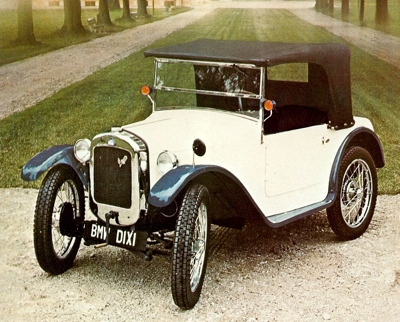
Looks like an Austin 7, but was the Dixi made under licence.
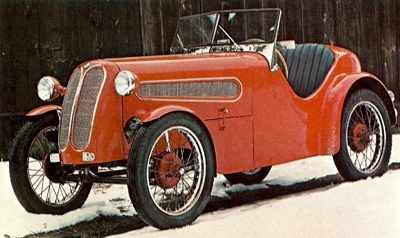
BMW Dixi Roadster, which had a top speed of 65 mph and was reasonably successful in competition, winning its class at the 1930 Monte Carlo Rally.
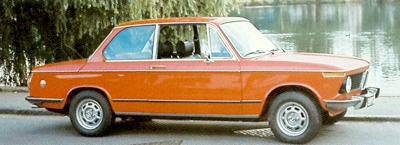
The BMW 2002, the car that made BMW's post war reputation what it is today.
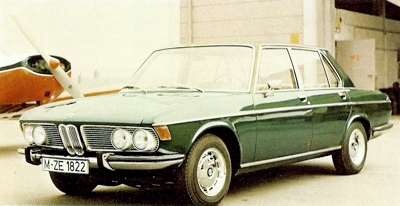
Introduced in 1968, the 2500 had a sweet six, which was the basis for the subsequent 3 liter sedans and coupes.
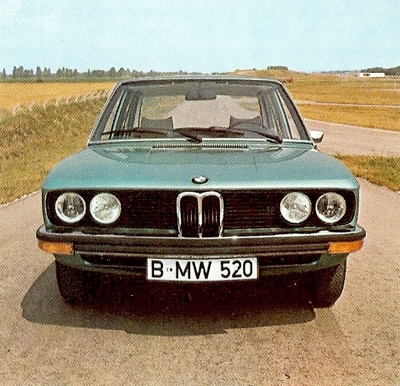
The BMW 520 was introduced in 1970, as a successor to the 2000 range.
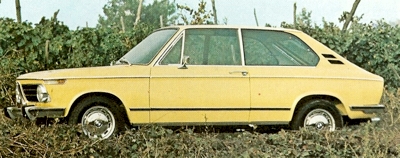
1971 BMW 2002 Touring, introduced as a 3 door sports version of the popular 2002 sedan.
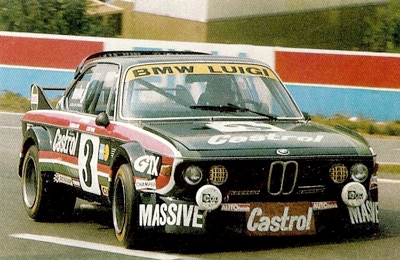
BMW have always been big in Motor Sport. For 1975, the Luigi was arguably the most successful, but there were plenty of privateers that also ded well.
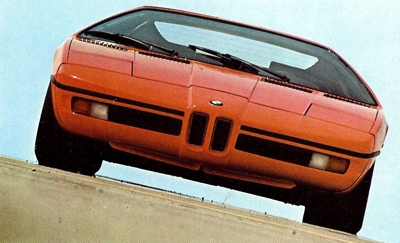
The BMW M1 was a styling exercise based on the 2002 turbo mechanicals.
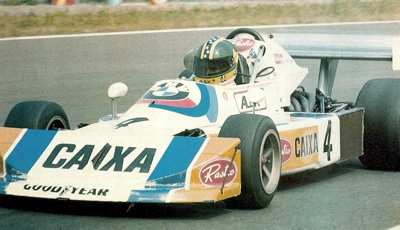
BMW's have also competed in Formula racing. Pictured above is Alex Riberio's March circa 1973. |
The next important stage in the company's development was later in 1936, when a two-liter 1975 cc engine was offered in the 326 model, complete with a sports-touring body. A simpler 320/321 version had only two doors and a single carburetor but this range was the first from BMW to feature the marque's now-distinctive 'vertical ovals' grille. As such cars edged towards sporting prominence, BMW motor cycles were also winning international laurels.
Henne Takes The 2 Wheel Speed Record
In 1929, Henne, already a circuit champion and 1928 motor cycle Targa Florio winner, became the first German to claim the absolute two-wheel speed record, on a BMW 750 twin. He went on to set the mark six more times, eventually leaving it at 174 mph in 1937, achieved with a super- charged 500 cc twin. BMW had at first tried a Rootes blower and then a Zoller unit and by 1945 was even contemplating a blown, 50 bhp, 500 cc Six-Day Trial bike.
Henne moved from two wheels to four in 1936, making his debut at the
Nurburgring in a 328. He won the two-liter class first time out, driving against pure racing cars and, by 1939, the starting grid for the
Nurburgring race found BMW 328s occupying the first four rows. Recognizing the potential, BMW decided to develop those cars and began with the 326/327 coupe and cabriolet models which produced 55 bhp. By fitting light-alloy cylinder heads with overhead valves opened by cross-over pushrods, larger ports and three Solex carburetors, the engines were improved enough to produce 80 bhp at 4700 rpm. This gave the cars a top speed of 95 mph, in normal customer trim, and the ability to cruise all day at 4000 rpm and 80 mph on the autobahn.
Customers could choose which set of gear ratios they wanted by specifying either a ZF or Hirth gearbox. Four of these cars started the 1938 Mille Miglia, finishing 7th, 9th, 10th and 11th overall to sweep their class. The same model won the Spa 24-hour race and went to Le Mans in 1939 with the first streamlined coupe bodies seen at the circuit, taking fifth place overall. With 100 bhp engines these cars could reach 125 mph and it was just such a 328 that scored the marque's crowning pre-war victory, coming first overall in the Brescia Mille Miglia of 1940.
BMW 335, The Last Of The Pre-War Models
So ended the pre-war story of BMW, except for the introduction of the 335 model. Announced in 1939 and fitted with a 3.5-liter six-cylinder engine developing 90 bhp, it was the largest BMW made up to that point. In the aftermath of World War 2 sheer survival took precedence over new-car production. The Allies declared that BMW should never rise again and they were nearly right: skilled men were occupied producing cooking pots and farm machinery rather than working on a wild BMW scheme to produce a turbine-engined locomotive.
bolle
The company's old workshops were taken over and became repair centres for the vehicles of the US Army. However, technical expertise would not be denied and even during those grim days the company was producing bicycles cast in aluminum - a few were made with even-lighter electron frames, but lack of tooling prevented volume production. The directors of BMW still nurtured plans to get back into the motor industry however, and they leaned towards producing a prestige car, ignoring the loss of parts and plans to Russian control in Eisenach which, after the war, became part of the German Democratic Republic.
By late 1945, this Eastern plant was planning to manufacture a copy of the 321, while the original BMW company could think only about producing motor cycles. In 1949, the Eisenach factory built the 340 model which featured an American-type radiator grille and a fascia-mounted gear change. The company even showed a 328 coupe and an S1 dream car, which featured a plexiglass top. The makers claimed that 130 bhp was produced from a developed 328 engine-but didn't say how. These last two cars were never marketed but the East Germans did export the 340 to Sweden, Belgium and Switzerland.
The Munich-based directors of the original BMW company were furious when customers applied to them for spare parts. Eventually, legal action forced the Eisenach company to become EMW and the badge to be a quartered red and white circle. Meanwhile, BMW's chief designer, Fiedler, had been lost to Bristol, although the Munich company retained the rights to any 328 development work used in Bristol's 400 model. Lacking blueprints, which had been lost, the design staff of BMW could only dream about a Karnm-railed K-1 model, which would have followed the 326 but for World War 2.
The Veritas, AFM, Frazer-Nash and Arnolt-Bristol annoy BMW Hierarchy
German news reporters further irritated the directors of the Munich company in 1947 by calling the Veritas, which featured a tuned 328 engine, a 'new BMW'. This small, specialist firm built road cars, sports racers and Formula Two cars and was successful in all classes but it could not sustain itself and eventually disappeared like so many others. Other companies continued to utilize the basic potential of the BMW six-cylinder engine. AFM used the engine in a single-seater racing car which went quite fast but, unfortunately, not for very long.
Frazer-Nash and Arnolt-Bristol similarly annoyed the hierarchy by fitting the motor-cycle engine into half a dozen miniature monoposto racing cars. Feeling threatened on all sides and with its finances and productive capacity still in an uncertain condition, the management of BMW debated whether to merge with another company - originally preferring Bristol which was not interested in the proposal but which did release Fiedler from his contract. BMW even talked to Auto Union, who wanted to formulate a common policy of two-stroke production. BMW found this proposal unacceptable and declined to proceed further with it.
Another plan to build a small Simca fell through over tooling difficulties and the company lacked sufficient experience for a proposed Ford truck venture to be pursued. Ford, Opel, Mercedes and Volkswagen had long since returned to production when BMW realized that the company could not afford to tool up for a mass-production motor car. A proposed two-liter, four-cylinder car was therefore out. Instead, BMW decided to build a small run of exclusive machines powered by the old, but still reasonably potent, six-cylinder unit, a thousand spare 326 blocks having been cast for just this purpose.
The BMW 501
This new model was designated the 501 and featured a fairly modest output from the engine, although an aluminum block V8 unit was running on the test bench early in 1949. BMW also commissioned a Pininfarina body, but used their own design because the Italian proposal looked remarkably like an Alfa Romeo. It was also around this time that the management vetoed a Fiedler designed, Fiat Topolino-like, two- seat prototype powered by the company's .twin-cylinder motor-cycle engine.
The 501 model quickly earned a reputation for technical superiority, even though it was too slow by the standards of the day. Priced at 50 times the average monthly wage of the German worker at that time, it cost far too much to reach its projected yearly sales. The V8 engine was delayed owing to a lack of finance and efforts to improve the six-cylinder engine brought only failure. By 1954, a 100 mph top speed was considered to be essential by the board of the company and the 502 model, with a 2.6 V8, was introduced in the same year. In 1955, BMW added the 503 coupe and 507 model to the range, but not even the recall of Hans Stuck to claim some hill-climb titles in a 507 could sell enough of them.
The Isetta Is Chosen
Nor did the company have any better luck with the 505 model intended for VIPs and statesmen - two limousine prototypes were built by Ghia Aigle but resistance from the market at which the car was aimed meant that the model was never put into production. Casting around for new avenues of expansion, BMW took a close look at the Isetta bubble car and decided that the company had the necessary expertise and facilities to produce it. It arranged a licence to produce them powered by the 250 cc motor-cycle engine with fan cooling.
These small, unusual cars proved to be quite popular for a short while, probably because the rise in the standard of living of so many Germans meant that they could now afford to become mobile once more. However, with the ever increasing rise in the standard of living, which was a strong feature of Germany throughout the fifties and sixties, people soon began to demand four seats and a more car-like shape than the Isetta could provide.
The Bank Suggests A Merger With Mercedes
What the public couldn't appreciate, however, was the over-engineered BMW 600 which was produced as an attempt to satisfy that demand. This, of course, caused further financial difficulties for the company and, when motor-cycle turnover, spare part sales and US Forces rents all declined, the banks which had supported the board of BMW suggested that the company be sold to Mercedes-Benz and it was left to the small shareholders in the company to frustrate that particular manoeuvre.
Perhaps by luck, but maybe by judgement, the answer to BMW's pressing financial problems was already in the prototype stage, in the shape of the Michelotti-designed BMW 700 which was first introduced in coupe form-even though the older members of the BMW board at first resisted its introduction. Powered by a rear-mounted, 697 cc air-cooled engine which developed 30 bhp, it provided a lively means of transport to the poorer members of the rapidly growing German bourgeois class. The car was even entered in competitions and the ageing Stuck was brought in to win just one more mountain hill-climb title with a developed version.
With this success, BMW at last had a sporting image on which it could capitalise and it was quick to see the possibilities and the potential and to act upon them. BMW quickly introduced a four-door 1500 model powered by an 80 bhp engine featuring a single ohc, which was put on the market before BMW finally phased out its big saloon and coupe line - despite a still-born plan to fit a Lancia Flaminia body to the basic 1500 running gear.
Salvation Courtesy of the BMW 1500
A massive success from its introduction, such was the popularity of the 1500, that production of all other motor cars ceased almost immediately, as the factory concentrated all its financial and industrial resources on penetrating the market as quickly and as deeply as possible. The company did not ignore the fact that progress had to be made if it was to keep up the commercial pressure and therefore build a solid foundation from which to operate. An 1800 cc model was developed quickly, but properly, along with an 1800 TI variant, the latter winning both the first circuit race and the first hill-climb in which it was entered.
By the end of March 1964, when the BMW V8 and the Isetta had been firmly buried, BMW enjoyed the best growth rate of any German manufacturer, even though the company had yet to crack the big limousine market. There was, however, the 2000 CS coupe, the forerunner to a 2-liter saloon, but a special Glas model, powered by the old V8 engine and introduced at the Frankfurt Motor Show of 1965, had attracted enormous attention and represented potential competition.
However,
Glas was in trouble and, although a few years earlier the Bavarian State had asked Glas to buy out BMW-and been refused-the bureaucrats had no compunction in now asking BMW to help Glas. Seeing the potential, BMW agreed and at first promised to up-date the Glas quality and to retain all Glas models. But the Glas line was soon pruned to a GT car, powered by a 2600 BMW engine and given the same badge and independent rear suspension, a V8 model enlarged to 3 liters and the Goggomobil, a small economy vehicle still quite popular among lower paid workers. It was fortunate that the South African outlet of BMW wanted to build a cheaper car and this company was given the Glas 1700 tooling plus a supply of BMW engines and badges.
1968 saw the demise of Glas as a separate entity. Even before that, BMW was moving so fast that the company introduced a 2000 model saloon, to mark the 50th anniversary of the company's founding, as well as a two door 1600-2, yet another hugely successful model which was to capture both track records and customers alike. That particular model became the basis for the 1602, 1802 and 2002 models and even a fastback estate version called the Touring, a sure sign of the company's increasing control of its market area and its own policies. By linking itself very successfully to a sporting image and taking the care to transfer this image to big, comfortable and very fast saloons and coupes BMW rapidly built up an enormously strong market position.
The 2002 model took the European Saloon Car Racing Championship in 1969 and another version of the model became the first turbocharged BMW to be offered to private customers. BMW also turned to single-seater racing, in 1973, with an F2 engine which powered the European Championship winning car in 1973, 1974 and 1975. However, the company's success in racing circles was based primarily on the BMW range of touring cars, which also proved to be eminently suitable for tuning by a wide range of European tuning specialists, both in Germany and elsewhere.
Such was the strength of the company that during the mid 1970's it was asked to help or take over several other motor manufacturers, as well as being a first-class contender in the merger stakes. Lack of capital led to BMW turning down an approach to take over Lancia, and fears that a US-built car would lack the German mystique cancelled a project planned with American Motors. Nor did BMW join with DAF which would have given the company a foothold in the lucrative European truck market.
BMW's First Love, the In-Line Six-Cylinder Engine
What increasing profitability did mean for BMW was that the engineers could turn back to their first love, the in-line six-cylinder engine. This unit was first introduced in a completely redesigned form in 1968. The success of the car and the quality of the basic design soon led to the engine being enlarged to 2.8 then to 3.0 and 3.3-liter, this unit powering both coupe and saloon versions. The 2500 was also the first BMW to be equipped with disc brakes on all four wheels. These and other items, such as fuel injection, aerofoils and air dams introduced on production.
BMWs, all combined to give the BMW racing department sufficient edge to beat all corners in the European Touring Car Championship of 1973 and again in 1975 with a privately entered car from tuners Alpina. Regardless of engine capacity, BMW have always built a sweet and supple chassis, usually one that all other cars are judged by. So good that, in nearly every review of a BMW that we have read, past and present, the reviewer states that the chassis could “handle more power”. BMW may not be the first car to come to mind when looking for a collectable, but if you are looking for a drivers car...
